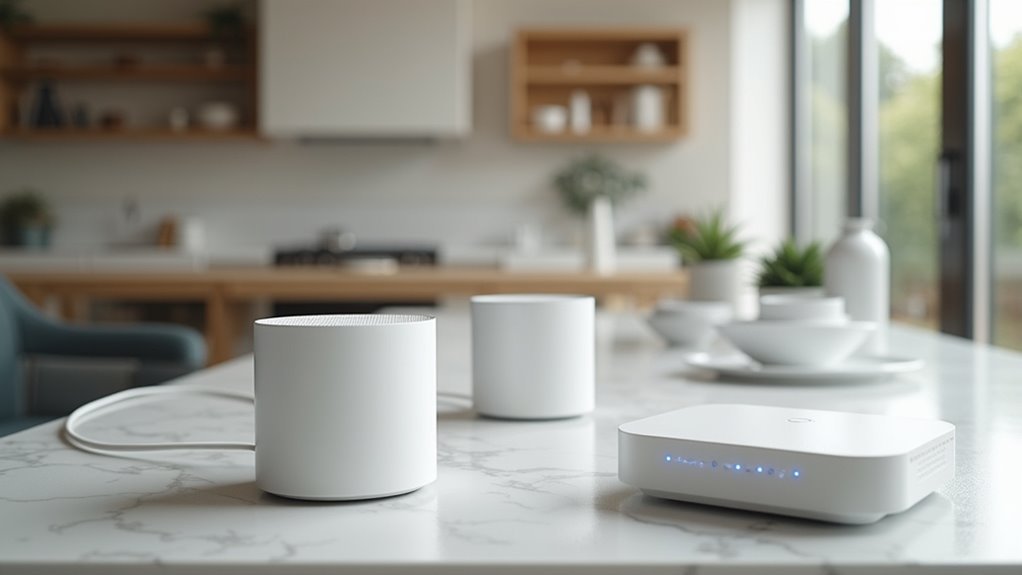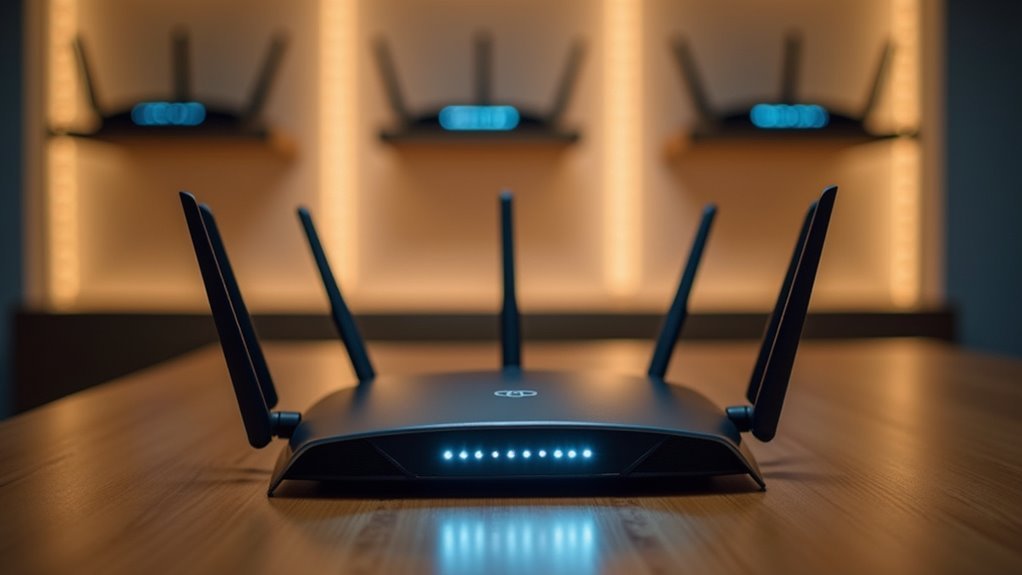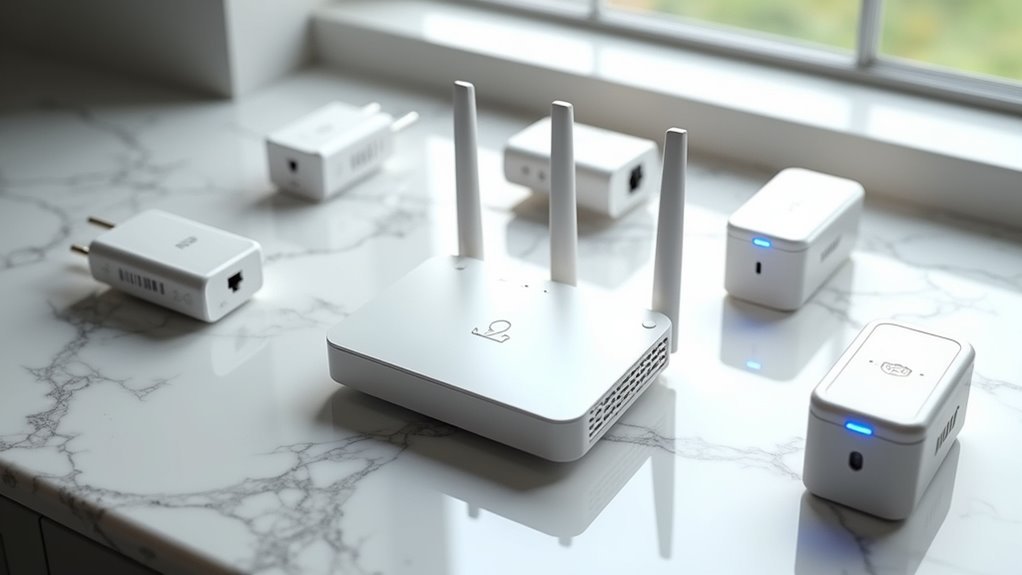You’ve invested in a mesh WiFi system, but you’re still experiencing dead zones and sluggish speeds in certain areas of your home. Your current setup isn’t delivering the seamless coverage you expected, and you’re wondering how to maximize your network’s potential without starting from scratch. The good news is that expanding and optimizing your existing mesh network doesn’t require technical expertise or expensive overhauls—just strategic improvements that’ll transform your connectivity.
Add Additional Mesh Nodes to Your Existing System

When your current mesh network leaves certain areas with weak or inconsistent WiFi coverage, you can expand coverage by adding additional mesh nodes to your existing system.
Most modern mesh systems like NETGEAR Orbi or Deco M9 Plus make this process straightforward and scalable. You’ll need to strategically position new nodes within range of your main router and existing nodes to guarantee peak performance and effective communication.
Strategic node placement within range of existing equipment ensures optimal mesh network performance and seamless device communication throughout your home.
Each additional node typically extends your coverage by 1,500 to 2,500 square feet, depending on your home’s layout and materials.
The key advantage is maintaining signal strength while preserving seamless connectivity. Your mesh network will continue using a single SSID, allowing your devices to automatically switch between nodes as you move throughout your home, ensuring uninterrupted internet access.
Optimize Node Placement for Maximum Coverage
After installing additional mesh nodes, proper placement becomes critical for achieving perfect coverage throughout your home.
Position your main router centrally in an open area to maximize signal distribution to all satellite nodes. Follow the two-room rule when placing additional nodes, keeping them within two rooms of each other for best communication.
Elevate your satellite nodes and keep them away from walls or large furniture that can weaken the signal.
When placing nodes across different floors, maintain a maximum distance of 30 feet to ascertain effective communication.
Use in-app signal tests or LED indicators to assess connection strength between nodes. Proper placement eliminates dead zones and dramatically improves WiFi performance throughout your entire home network.
Upgrade to Higher-Performance Mesh Hardware

When your current mesh system can’t keep up with your household’s demanding internet needs, upgrading to higher-performance hardware like WiFi 7-enabled routers delivers transformative speed improvements of up to 27Gbps.
You’ll experience dramatically faster downloads, smoother 4K/8K streaming, and lag-free gaming that your existing setup simply can’t match.
Modern mesh systems also incorporate quad-band technology with dedicated backhaul channels, eliminating the bottlenecks that slow down your network when multiple devices compete for bandwidth.
WiFi 7 Speed Benefits
Five revolutionary features make WiFi 7 technology a game-changer for mesh network performance, with systems like the NETGEAR Orbi 970 delivering unprecedented speeds up to 27Gbps.
You’ll experience dramatically improved data transfer rates that transform your mesh WiFi system’s capabilities for demanding applications like 4K/8K streaming and gaming. Multi-link operation enables simultaneous connections across multiple channels, boosting throughput while reducing latency for your connected devices.
- 320MHz channel support provides wider data highways, accommodating more devices without performance degradation.
- Automated Frequency Coordination intelligently selects best channels, minimizing interference for superior reliability.
- Enhanced network performance supports bandwidth-intensive activities across multiple users simultaneously.
- Future-proofing guarantees compatibility with emerging smart home technologies requiring higher data speeds.
Quad-Band Technology Advantages
Four frequency bands working in harmony transform your mesh network’s performance capabilities, with quad-band technology delivering the dedicated backhaul channel that eliminates the bottlenecks plaguing traditional systems.
You’ll experience WiFi speeds reaching up to 27Gbps while supporting more connected devices simultaneously without performance degradation.
Your mesh routers benefit from reduced interference and enhanced node communication, ensuring faster data transfer with lower latency throughout your home.
You can stream 4K content, game online, and run multiple smart devices without compromising network quality.
The extra frequency band provides superior connectivity by mitigating neighboring network interference, making quad-band technology essential for network expansion in larger homes or complex layouts requiring reliable, high-speed internet access across every corner.
Use Wired Backhaul Connections Between Nodes
You’ll dramatically boost your mesh network’s performance by connecting nodes with Ethernet cables instead of relying solely on wireless backhaul.
Setting up wired connections between your mesh points eliminates interference and provides the stable, high-speed backbone your network needs for demanding applications like 4K streaming and gaming.
Understanding when to choose wired over wireless backhaul connections will help you maximize your system’s potential and create the most reliable network possible.
Enhanced Performance Benefits
When you’re looking to maximize your mesh network’s potential, wired backhaul connections between nodes deliver substantial performance gains that wireless connections simply can’t match.
By establishing dedicated Ethernet pathways, you’ll experience dramatically reduced latency and enhanced network speed across your entire coverage area.
Your WiFi mesh system transforms into a powerhouse when you implement wired backhaul, supporting multiple high-demand devices simultaneously without sacrificing connectivity quality.
You’ll also notice improved reliability as interference from wireless signals becomes virtually eliminated.
- Higher bandwidth capabilities – Stream 4K content while gaming online without buffering
- Extended coverage range – Maintain strong signals across greater distances between nodes
- Reduced dead zones – Eliminate weak spots throughout your home or office
- Enhanced stability – Experience consistent performance during peak usage periods
Ethernet Cable Setup
Although setting up Ethernet backhaul requires some initial planning, the process itself is straightforward and delivers immediate performance improvements.
You’ll need to connect each satellite node to your main router using an Ethernet cable, ensuring nodes are positioned within reach of power outlets. Modern mesh systems automatically detect wired backhaul connections and optimize accordingly.
Use Cat 5e or higher quality cables to maintain signal integrity over longer distances. This wired backhaul setup eliminates wireless interference while dramatically increasing available bandwidth for your connected devices.
You’ll notice enhanced performance immediately, especially during high-demand activities like 4K streaming or gaming. The direct cable connections create a dedicated highway between nodes, freeing up wireless channels for your devices rather than inter-node communication.
Wireless Versus Wired
While wireless mesh networks offer impressive convenience and flexibility, wired backhaul connections between nodes represent the gold standard for peak performance and reliability.
You’ll experience considerably reduced latency and increased bandwidth when your mesh devices communicate through Ethernet cables rather than wireless signals. This setup minimizes interference from obstacles and competing networks while freeing up Wi-Fi signal capacity for your smartphones, laptops, and smart home devices.
Consider these wired backhaul advantages:
- Enhanced stability – Ethernet cables provide consistent connections unaffected by wireless interference
- Improved bandwidth – Direct wired connections maximize data transfer speeds between nodes
- Reduced congestion – Wireless spectrum remains available exclusively for end-user devices
- Superior range – Strategic cable placement enables optimal performance across rooms and floors
Choose systems supporting both wired and wireless backhaul for peak flexibility.
Configure Dedicated 5GHz Bands for Device Communication
Since most households now operate dozens of connected devices simultaneously, configuring dedicated 5GHz bands becomes essential for maintaining peak network performance.
Your mesh network can leverage these dedicated 5GHz bands to enhance device communication while reducing congestion on the overcrowded 2.4GHz spectrum. The 5GHz band delivers higher speeds and lower latency, perfect for bandwidth-intensive activities like gaming and streaming 4K content.
You’ll achieve ideal performance by accessing your mesh router’s management app or web interface to assign specific devices to dedicated bands. This configuration guarantees connection stability for demanding devices such as smart TVs and gaming consoles.
Modern mesh systems automatically allocate devices based on their capabilities, but manual configuration gives you precise control over your WiFi signal distribution and prioritization.
Position Nodes to Eliminate WiFi Dead Zones

Proper node positioning eliminates WiFi dead zones and transforms your home into a seamlessly connected environment.
Strategic placement of your router and satellite nodes guarantees ideal coverage throughout every room. Position your main router centrally to maximize signal distribution across your home. Place additional nodes following the two-room rule, maintaining no more than 30 feet between floors for strong connectivity.
- Central router placement – Position your main router in the center of your home to distribute WiFi signals evenly
- Open area positioning – Avoid walls and furniture that obstruct signal transmission between nodes
- Two-room spacing – Place satellite nodes within proper range to maintain effective communication
- Signal testing – Use in-app tests after placement to verify coverage and adjust node positions accordingly
Extend Coverage to Outdoor Areas With Weather-Resistant Nodes
You’ll need weather-resistant mesh nodes to bring reliable WiFi to your outdoor spaces without worrying about rain, snow, or extreme temperatures damaging your equipment.
These specialized nodes feature enhanced antennas and higher power output that can extend coverage up to 50 meters or more from your main router.
Strategic placement becomes essential since you’ll want to position these outdoor nodes within range of your indoor network while avoiding obstacles like thick walls or dense foliage that could weaken the signal.
Weatherproof Node Options
While indoor mesh networks excel at eliminating dead zones inside your home, extending that same reliable coverage to outdoor spaces requires specialized weatherproof nodes designed to handle Mother Nature’s challenges.
Weatherproof nodes like the NETGEAR Orbi Outdoor Satellite deliver robust WiFi coverage to gardens, patios, and yards while enduring harsh conditions.
These devices feature enhanced sealing and durable materials that protect against moisture and dust, ensuring your mesh network operates reliably year-round.
- Extended Range: High-gain antennas provide WiFi coverage up to 1,000 feet in open outdoor spaces
- Weather Resistance: Enhanced sealing protects against rain, snow, and extreme temperatures
- Seamless Integration: Connects directly to your main router or existing mesh network
- Smart Device Support: Eliminates dead zones for outdoor cameras and sensors
Optimal Outdoor Placement
Having the right weatherproof equipment means nothing if you don’t position it correctly for maximum coverage.
Strategic placement of outdoor nodes requires careful consideration of distance and elevation. Keep your outdoor nodes within 30 feet of the main router to maintain strong communication and prevent dead zones.
Position nodes in elevated locations with clear line of sight to minimize obstructions that weaken signal transmission.
Use network management apps to monitor signal strength in real-time, allowing you to adjust placement based on actual performance data. This approach helps you extend coverage effectively across your outdoor spaces.
When possible, connect outdoor nodes through Ethernet backhaul rather than wireless connections to guarantee stable, high-performance connectivity throughout your expanded network.
Replace Wifi Extenders With Compatible Mesh Satellites
When your current WiFi extenders create more problems than they solve, replacing them with compatible mesh satellites transforms your network into a unified system that eliminates the performance bottlenecks you’ve been experiencing.
Unlike traditional extenders that cut bandwidth in half, mesh satellites communicate seamlessly with your existing router to maintain peak speeds throughout your home network.
Mesh satellites work with your router to deliver full-speed connectivity instead of the reduced performance traditional extenders provide.
- Unified connectivity: All devices use the same SSID and password, enabling automatic roaming without reconnecting
- Consistent performance: Mesh satellites maintain strong signal strength across complex layouts, eliminating dead zones
- Easy scalability: Add more satellites as needed without additional configuration or performance loss
- Future-ready technology: Advanced systems like NETGEAR Orbi offer WiFi 7 capabilities for modern smart homes
This upgrade delivers seamless WiFi coverage while future-proofing your network with cutting-edge WiFi technology.
Adjust Antenna Positioning and Beamforming Settings
Since most mesh systems come with adjustable antennas and built-in beamforming technology, you can dramatically improve your network’s performance by fine-tuning these settings to match your home’s specific layout and usage patterns.
Adjusting antenna positioning on your mesh nodes creates more focused WiFi signals toward specific areas rather than broadcasting uniformly. This directional approach helps mitigate interference from walls and furniture that typically weaken WiFi performance.
| Antenna Angle | Coverage Area |
|---|---|
| Vertical (90°) | Multi-floor homes |
| Angled (45°) | Single-floor spread |
| Horizontal (0°) | Long corridors |
| Mixed positioning | Complex layouts |
| App-optimized | Device-specific targeting |
Access your mesh network’s app to modify beamforming capabilities and prioritize specific devices. Regularly review these settings based on network usage patterns to maintain ideal coverage and speed throughout your home.
Enable Band Steering and Load Balancing Features
While antenna positioning enhances signal direction, enabling band steering and load balancing features transforms how your mesh network intelligently manages device connections and traffic distribution.
Band steering automatically redirects dual-band devices to the less congested 5GHz band, reducing interference and enhancing connectivity. Load balancing prevents network bottlenecks by distributing devices evenly across mesh nodes, ensuring ideal performance throughout your home.
Access your mesh network’s management app to activate these features:
- Enable automatic band steering to direct devices away from crowded 2.4GHz frequencies
- Activate load balancing to prevent single nodes from becoming overloaded with connections
- Monitor real-time analytics for device distribution and bandwidth usage patterns
- Fine-tune settings based on performance data to maximize speed and reduce latency
Proper configuration considerably improves data transfer rates, especially in homes with numerous connected devices.
Frequently Asked Questions
How to Expand a Mesh Network?
You’ll add compatible nodes within range of your main router. Check your system’s maximum capacity, position nodes strategically using the two-room rule, and use your mobile app for installation guidance.
How to Maximize Mesh Wifi?
You’ll maximize mesh WiFi by positioning your main router centrally, placing satellites using the two-room rule, utilizing wired backhaul connections, conducting regular signal tests, and keeping firmware updated consistently.
How Can I Boost My Mesh Wifi Signal?
You’ll boost your mesh WiFi signal by positioning nodes strategically, using Ethernet backhaul connections, updating firmware regularly, reducing interference from electronics, and conducting signal tests through your system’s mobile app.
Can I Add an Extender to a Mesh Network?
You can technically add an extender to your mesh network, but it’s unnecessary and potentially problematic. Instead, you’ll get better results by adding another mesh node for seamless coverage.





Leave a Reply